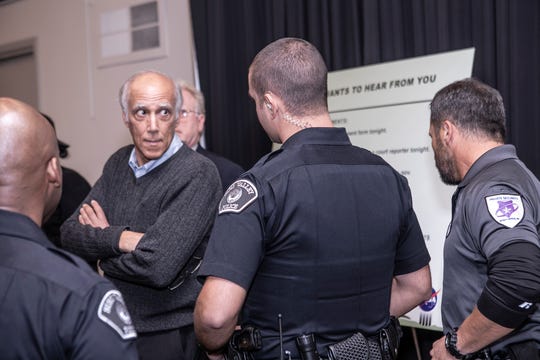The 2,850-acre field lab in unincorporated hills just southeast of Simi Valley experienced the partial nuclear meltdown in 1959 when it was the Rocketdyne/Atomics International rocket engine test and nuclear facility. The site also experienced other chemical and radioactive contamination over the years.
ARTICLE BY MIKE HARRIS | vcstar.com

Fireworks erupted this week at a NASA public meeting on the much-delayed cleanup of a 1959 partial nuclear meltdown at the Santa Susana Field Laboratory outside Simi Valley.
Longtime cleanup activist Dan Hirsch, president of the Committee to Bridge the Gap, a nonprofit nuclear policy organization, said he was asked by Simi Valley police to leave Wednesday night’s meeting at the Best Western Posada Royale after trying unsuccessfully to present a slide show.
The meeting was held to allow the public to comment on NASA’s recently released Draft Supplemental Environmental Impact Statement regarding cleaning up its portion of the field lab site.
Hirsch, the retired director of the Program on Environmental and Nuclear Policy at UC Santa Cruz, alleges that by issuing the draft supplemental statement, NASA is proposing to violate a legally binding cleanup agreement it entered with the state in 2010.
Hirsch said he had a constitutional right to testify at the meeting and present the slide show.
But Simi Valley Police Chief Dave Livingstone said NASA security personnel called police about Hirsch allegedly being disruptive.
“Our supervisor at the scene asked him to leave voluntarily and he did, but only after finishing his rant,” Livingstone said Thursday.
Santa Susana Field Lab cleanup activists question the Department of Toxic Substances Control’s conclusion about the American Jewish University’s Brandeis-Bardin campus outside Simi Valley. MIKE HARRIS/THE STAR
Simi Valley Police Department Cmdr. Steve Shorts, a department spokesman, said Friday that officers told Hirsch “if he didn’t voluntarily leave, it would be trespassing because NASA had rented the room.”
Shorts stressed that the officers didn’t witness the alleged disruptive behavior.
“We don’t know what NASA’s rules are for meetings, how speakers are dismissed, because the federal system is not the same as our system,” he said. “At the county and the city, people have to have open comments.”
A NASA special agent who was at the meeting, Jerry Jennings, said Friday he likely wouldn’t get permission from his superiors to comment before Monday.
Hirsch said he brought his own projector and screen and tried to show the presentation while giving his oral comments.
“But the NASA people physically blocked that from happening,” he said with a laugh. “They put their bodies between my PowerPoint projector and the screen. I still can’t quite believe it.”
The confrontation went on for about 15 minutes and NASA eventually unplugged the projector, he said.
A few minutes later, as Hirsch was still standing in line to simply speak, “about eight police officers arrive and order me to leave the hall,” he said.
“And as I am escorted out, the crowd is cheering me,” he said.
‘More soil needs to be removed’
The 2,850-acre field lab in unincorporated hills just southeast of Simi Valley experienced the partial nuclear meltdown in 1959 when it was the Rocketdyne/Atomics International rocket engine test and nuclear facility. The site also experienced other chemical and radioactive contamination over the years.
Most of the site is now owned by Aerospace giant Boeing and is divided into four areas with northern and southern buffer zones.
NASA administers a smaller portion of the site and is responsible for cleaning up Area 2 and its part of Area 1.
NASA released its final Environmental Impact Statement for the cleanup in 2014.
But the agency says it was required by federal law to release the draft supplemental Environmental Impact Statement late last month. NASA says that is because it has determined that substantially more soil needs to be removed from its part of the site than what it estimated in the 2014 report.
“But while there’s more dirt to be removed, there’s not more contamination,” NASA spokesperson Shannon Segovia said Thursday.
Hirsch isn’t buying that.
“The new information is that they’ve discovered much more contamination on their property than they had previously known,” he said.
The supplemental statement proposes four levels of cleanup. Only one of them is strict enough to be consistent with the 2010 cleanup agreement NASA signed with the California Department of Toxic Substances Control to clean up all contamination at its portion of the site.
The other three would clean the site up to lesser standards.
Regardless, “all alternatives in the draft SEIS are protective of public health and the environment,” the agency says.
NASA says it will announce which of the cleanup plans it prefers in the final supplemental report, which it anticipates releasing in 2020.
But Hirsch said no one should expect NASA to select the most stringent alternative that would uphold the 2010 agreement.
“There’s no reason to do the supplemental proposing these three alternatives except they are proposing to break the agreement,” he said.
The public comment period started Oct. 25 when the draft supplemental statement was posted to the federal register and will last until Dec. 9.
Members of the public who wish to comment on the draft statement can do so via email, msfc-ssfl-eis@mail.nasa.gov or traditional mail to Peter Zorba, NASA SSFL Project Director, 5800 Woolsey Canyon Road, Canoga Park, CA 91304.
Mike Harris covers the east county cities of Simi Valley and Thousand Oaks, as well as transportation countywide. You can contact him at mike.harris@vcstar.com or 805-437-0323.
